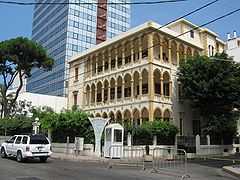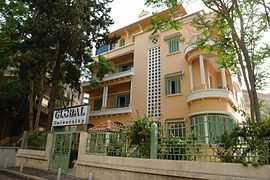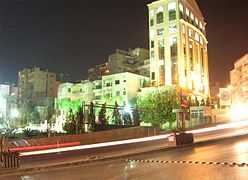Education in Lebanon
Education in Lebanon is regulated by the Ministry of Education and Higher Education (MOEHE). In Lebanon, English or French with Arabic are taught from early years in schools. English or French are the mandatory medium of instruction for mathematics and science for all schools.[1] Education is compulsory from age 6 to age 14.[2]
According to a 2013 World Economic Forum report, Lebanon is ranked 10th in overall quality of education, and 4th in science and math,[3] These rankings are based on the Executive Opinion Survey, carried out as part of the WEF's Global Competitiveness Report, based on polling a sample of business leaders in each respective country. In 2014, the country ranked second in MENA (behind qatar) in terms of quality of primary education and net enrollment rate. Lebanon's adult and youth literacy rates rank among the highest in the MENA region. [4][5]
Education system
Education in Lebanon is divided into 5 cycles split in 3 phases: Pre-school education, basic education, and secondary education, the latter ending on a Baccalaureat or a "profesionnal certificate", which both give access to tertiary education.[6] Education is compulsory age 6 to age 14, being the basic education cycle.[2] Pre-school education (cycle 1) starts at age 3 or 4. Basic education is then composed of two levels: elementary level and intermediate level. Elementary level is grade 1 to 3 (cycle 2) and grades 4 to 6 (cycle 3). Intermediate level is grades 7 to 9 (cycle 4). Secondary Education is grades 10 to 12 (cycle 5). Secondary Education is usually completed at age 18.[6]
Pre-school education
According to the World Bank database, gross enrollment rate of pre-school education is 67.1 percent for male, 65.6 percent for female, and 66.4 percent for total in 2007.[7] Pre-school education aims to initiate children into the school environment. The goal of pre-school education is 1) to create a favorable climate for the children to communicate with others, 2) to develop their physical capacities, limb control and coordination of their movements, and 3) to educate their senses. Pre-school education also takes into account physiological moral and intellectual development of children.[8] According to the World Bank database, private enrollment share for pre-school education is 80.3 percent in 2008.[7]
Basic education
Elementary Level
According to the Worlds database, gross enrollment rate of elementary level of basic education is for 96.8 percent for male, 93.9 percent for female, and 95.4 percent for total in 2007. Private enrollment share in elementary level is 67.6 percent in 2007.[7]
Intermediate level
According to the World Bank database, gross enrollment rate of intermediate level is 83.2 percent for male, 90.7 percent for female, and 86.9 percent for total in 2007. (The World Bank Edstats) Primary completion rate of Lebanon (US$6,000 GNI per capita in 2007) is lower than that of Tunisia, Jordan, Iran, Algeria, West Bank and Egypt (all of which have lower GNI per capita). Primary completion rates have not improved during the period 1995/96 to 2003/04.[9] In 2007, Primary completion rate is 79.8 percent for male, 83.3 percent for female, and 81.5 percent for total.[7] According to UIS database, technical and vocational enrollment as percent of total enrollment in intermediate level is 5.1 percent in 2008.[8] Private enrollment share of general education in intermediate level is 60.2 percent and that of technical and vocational education is 56.8 percent in 2008.[8]
Secondary education
Secondary education is three years education, and composes of general education (humanities, economics, life sciences, general sciences) and technical education (about 55 different fields of study). School principals decide students’ path based on students’ aptitude as shown by the Brevet examination results. When students complete three years education, they take official Lebanese Baccalaureate exams in their respective tracks (four in all). Students who finish examinations successfully obtain the Lebanese Baccalaureate Certificate of Secondary Education (Shahaadat Al-Bakaalouriya al Lubnaaniya l’il-ta ‘liim al-Thaanawi) or the Technical Baccalaureate (Al-Bakaalouriya al-Finniya)[10]
Palestinian refugees in Lebanon have limited access to public secondary education. Most of them are not able to afford the high cost of private secondary education. UNRWA operates three secondary schools in Beirut, Saida and Tyre. School operated by UNRWA partially offset the absence of available educational opportunities at the secondary school level. (UNRWA website) According to the World Bank database, gross enrollment rate of secondary education is 69.8 percent for male, 80.2 percent for female, and 74.9 percent for total.[7] According to UIS database, technical and vocational enrollment as percent of total enrollment in secondary level is 27.8 percent in 2008.[8] Private enrollment share of general education in intermediate level is 49.8 percent and that of technical and vocational education is 56.9 percent in 2008.[8]
Lebanon participated in TIMSS in 2003 and 2007. Score of mathematics at 8th grade is 433 in 2003 and 449 in 2007.[11] Score of science at 8th grade is 435 in 2003 and 404 in 2007.[12] At the end of middle school, each student has to enter the official exams.
Tertiary education
Tertiary education in Lebanon is composed of Technical and Vocational Institutes, University colleges, University Institutes and Universities. The Lebanese University is the only public institution. The Ministry of Education and Higher Education administrates the private and public sectors and Technical and Vocational Institutes are under the Directorate General of Technical and Vocational Education Directorate General of Higher Education has responsibility for University Colleges, University Institutes and Universities).[10]
According to the World Bank database, gross enrollment rate of tertiary education is 46.9 percent for male, 56.3 percent for female, and 51.6 percent for total. (The World Bank 2009) Private enrollment share of tertiary education is 53.4 percent.[13]
Female students are seen in every university program or field of specialization.[13]
The Lebanese Baccalaureate is accredited worldwide. French Baccalaureate can be presented by students who have other nationality than the Lebanese. The French Baccalaureate is also accredited.
While the Lebanese educational system offers a high quality education, many of the young people it graduates tend to leave the country to work abroad; An overwhelming majority of emigrants (77%) between 2004 and 2009 were young people under 35 years, many of whom are well-educated and highly skilled professionals (44% of those who emigrated held university degrees),[14] which exacerbates the loss to Lebanon in terms of economic and social advancement. Another key statistic is the youth unemployment rate in Lebanon which has reached 24%.[15] Unemployment rates are particularly high among highly skilled people, specifically university-educated individuals, who typically spend more than a year after graduation looking for a decent job in Lebanon, and then decide to leave after either not finding any employment or refusing to take a job which is well-below their qualifications.[14] Although the higher education system in Lebanon is highly developed, some of the issues that characterize it are particularly salient to the youth unemployment problem since this system is directly responsible for preparing a majority of the Lebanese youth for the labor market. With university graduates making up 30% of people seeking a job,[16] it is clear that the Higher Education system needs to play a key role in resolving the problem of youth unemployment in Lebanon. The key issue related to this sector is the mismatch between the highly skilled graduates that universities supply and the skills and professionals the labor market demands; these supply-demand failings in the labor market are increasingly preventing young people from finding a job in their country that fits their qualifications.[17] In order to address these issues, universities can implement policies to: 1. Reform the curricula to better prepare graduates for their professional life 2. Improve career guidance structures and activities 3. Invest in relevant research, statistics and data gathering.
Lebanon has 41 nationally accredited universities, several of which are internationally recognized.[18][19] The American University of Beirut (AUB) and the Université Saint-Joseph (USJ) were the first Anglophone and the first Francophone universities to open in Lebanon respectively.[20][21] The forty-one universities, both public and private, largely operate in French, or English as these are the most widely used foreign languages in Lebanon.[22]
At the English universities, students who have graduated from an American-style high school program enter at the freshman level to earn their baccalaureate equivalence from the Lebanese Ministry of Higher Education. This qualifies them to continue studying at the higher levels. Such students are required to have already taken the SAT I and the SAT II (Subjects Test) upon applying to college, in lieu of the official exams. On the other hand, students who have graduated from a school that follows the Lebanese educational system are directly admitted to the sophomore year. These students are still required to take the SAT I, but not the SAT II.
The highest-ranked and most prestigious universities in Lebanon include the Université La Sagesse (ULS), the Modern University for Business and Science (MUBS), the Lebanese University (LU), the American University of Science and Technology (AUST), the Lebanese American University (LAU), the Antonine University (UPA), the University of Balamand (UOB), the American University of Beirut (AUB), Beirut Arab University (BAU), the Lebanese International University (LIU), Haigazian University (HU), the Université Saint-Joseph (USJ), the American University of Technology (AUT), the Arts, Sciences and Technology University in Lebanon (AUL), the Université Saint-Esprit de Kaslik (USEK), the Notre Dame University - Louaize (NDU), and the Modern University for Business and Science (MUBS). In addition, some students choose to study abroad. The United Nations assigned Lebanon an Education Index of 0.84 in 2005.[23]
Not all private higher educational institutions in Lebanon consider SAT I or SAT II for undergraduate admissions. The majority require a local entrance test prepared by these individual higher educational institutions. In most times, the entrance test is a placement test. The main requirement for undergraduate admissions for Lebanese students is the secondary-school leaving certificate called the Baccalaureate II or more recently the International Baccalaureate. However, students with a foreign nationality are admitted to private higher education institutions that pattern after the American system of higher education as Freshman students in case they do not have an equivalence to the Baccalaureate II. In case they obtain an equivalence from the Ministry of Education and higher Education, they are admitted as sophomore students. As for the Lebanese University, which is the only public higher educational institution in Lebanon, students are admitted to undergraduate programs based on their Baccalaureate II. A number of Faculties at the Lebanese University, such as the Faculty of Sciences require further testing for selectivity based on entrance tests (concurs) prepared and administered by this faculty.
-

AUB established in 1866 by the American Board of Commissioners for Foreign Missions
-

Haigazian University was founded in 1955 by the Armenian Evangelical community
-

Saint Joseph University, or Université Saint-Joseph, founded by the Jesuits in 1875
-

Holy Spirit University of Kaslik, or Université Saint-Esprit de Kaslik, founded by the Lebanese Maronite Order (LMO) in 1950
-

NDU, founded by the Maronite Order of The Holy Virgin Mary in 1978
-

AUT in Halat, North Lebanon
-

Global University in Beirut
-

École supérieure des affaires, founded in 1996 as a joint cooperation between the Paris Chamber of Commerce (Chambre de Commerce et d'Industrie de Paris) and the Bank of Lebanon
Education management
Ministry of Education and Higher Education (MOEHE) regulates all education institutes in the public sector through a regional education system. The education system in Lebanon is centralized, and this regulation is not direct. The education system is managed through regional education bureaus. Public schools are monitored by the regional education bureaus in the governorates. The regional education bureau serves as liaisons between the public school and the directorates of education at the ministry's headquarters. Private schools have their own organization, but private schools are still subject to the authority of the MOEHE.[24]
The Center for Educational Research and Development (CERD) is an autonomous staff organization under the trusteeship of the MOEHE. CERD's tasks are 1) to draft curricula of academic and vocational education for the pre-university education stage, 2) to revise and modify the curricula according to the necessity, 3) to prepare all means and ways for applying these curricula, 4) to do educational research, 5) to secure training for pre-university teachers, 6) to prepare the curricula in all subject areas, 7) to provide teacher training, 8) to write textbooks, and 9) to conduct evaluations, etc.[24]
Education finance
According to the World Bank database, public education expenditure as percentage of GDP is 2.7 in 2007 and public education expenditure as percent of government spending is 9.6 in 2007.[7] Public schools are financed by the Ministry of Education and private schools are financed by students' fees. The processes involved curricula draft and modification, and teacher training are mainly financed by nongovernment funds such as private companies or international bodies which include the World Bank and the UNDP.[24]
Curriculum
The Lebanese curriculum is used at all public and private schools in Lebanon. Schools have to apply both the Lebanese and foreign schemes at the same time when they will implement a foreign curriculum (French, English, or international) in a school.[24]
See also
References
- ↑ "The World Bank (2006) Lebanon Quarterly Update, First Quarter 2006, Beirut: The World Bank" (PDF).
- ↑ 2.0 2.1 "Lebanon: early Childhood care and education programmes" (PDF). UNESCO-IBE. 2006. Retrieved June 2014.
- ↑ Lanvin, Bruno; Dutta, Soumitra, eds. (2013). "The Global Information Technology Report 2013: Growth and Jobs in a Hyperconnected World" (PDF). World Economic Forum. Geneva. pp. 324–325. Retrieved 5 February 2014.
- ↑ Lanvin, Bruno; Dutta, Soumitra, eds. (2013). "The Global Information Technology Report 2013: Growth and Jobs in a Hyperconnected World" (PDF). World Economic Forum. Geneva. p. 289. Retrieved 5 February 2014.
- ↑ Schwab, Klaus; Sala-i-Martin, Xavier; Brende, Børge (2013). "The Global Competitiveness Report 2013–2014: Full Data Edition" (PDF). World Economic Forum. Geneva. pp. 83–85. Retrieved 5 February 2014.
- ↑ 6.0 6.1 "Vocational Education in Lebanon". UNESCO-UNEVOC. October 2012. Retrieved 23 June 2014.
- ↑ 7.0 7.1 7.2 7.3 7.4 7.5 "The World Bank Edstats database".
- ↑ 8.0 8.1 8.2 8.3 8.4 "UNESCO Institute for Statistics database".
- ↑ "The World Bank (2008) Project Information Document, Concept Stage, Lebanon Second Emergency Social Protection Implementation Support Project, Washington D.C.: The World Bank" (PDF).
- ↑ 10.0 10.1 "International Association of University, World Higher Education Database".
- ↑ "Mullis, Ina V.S. et al. (2008) TIMSS 2007 International Mathematics Report: Findings from IEA's Trends in International Mathematics and Science Study at the Fourth and Eighth Grade, MA: TIMSS and PIRLS International Study Center." (PDF).
- ↑ "Martin, Michael O. et al. (2008) TIMSS 2007 International Science Report: Findings from IEA's Trends in International Mathematics and Science Study at the Fourth and Eighth Grade, MA: TIMSS and PIRLS International Study Center" (PDF).
- ↑ 13.0 13.1 "The World Bank (2009) The Status and Progress of Women in the Middle East and North Africa, Washington D.C.: The World Bank" (PDF).
- ↑ 14.0 14.1 Yaacoub, Najwa, and Lara Badre. The Labor Market in Lebanon. Statistical report, Beirut: Central Administration of Statistics , 2011.
- ↑ Mary Kawar and Zafiris Tzannatos, Youth Employment in Lebanon: Skilled and Jobless, Lebanese Center for Policy Studies, 2013
- ↑ Youth Economic Forum, Youth Employment: Towards an Improved Regulation of the Labor Market, 2012
- ↑ Di Bartolomeo, Anna, Tamirace Fakhoury, and Delphine Perrin. CARIM – Migration Profile. European University Institute – Robert Schuman Centre For Advanced Studies, 2010
- ↑ Infopro Management. "Lebanon Opportunities – Business Information". Retrieved January 30, 2007
- ↑ Arabic)Lebanese Directory of Higher Education. "Decrees". Retrieved January 30, 2007
- ↑ eIFL.net Regional Workshop (2005). "Country Report: Lebanon". Retrieved December 14, 2006
- ↑ Université Saint-Joseph. "125 years of history – A timeline". Retrieved December 8, 2006
- ↑ Yalla!. "Yalla! Students". Retrieved December 15, 2006
- ↑ ""Human development indicators" (PDF). United Nations Development Programme, Human Development Report" (PDF).
- ↑ 24.0 24.1 24.2 24.3 "Skaf, Antoine and Zeina Habib (2008) "Lebanon" In Ina V.S. Mullis, Michael O. Martin, Joh F. Olson, Dbra R. Berger, Dana Milne, and Gabrielle M. Stanco ed., TIMSS 2007 Encyclopedia: A Guide to Mathematics and Science Education Around the World, Volume 2, Boston: TIMSS & PIRLS International Study Center" (PDF).
External links
- Ministry of Education, Lebanon
- World Data on Education: Lebanon, UNESCO-IBE(2011) - Overview of the Lebanese education system
- Vocational Education in Lebanon, UNESCO-UNEVOC(2012) - Overview of the vocational system in Lebanon
| ||||||||||||||
